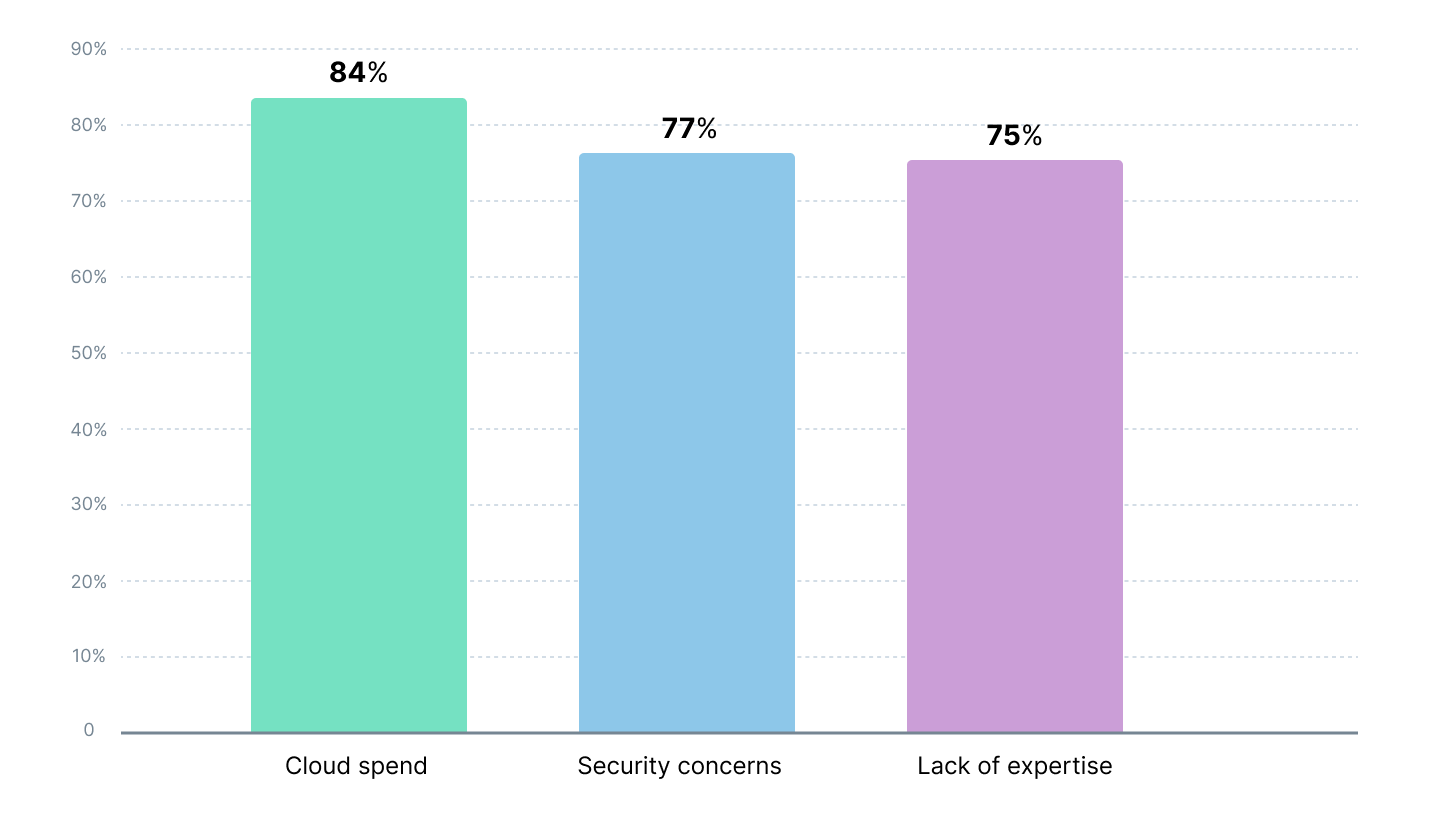Your cloud bills have arrived. And once again, you’re staring at line items that make no sense, wondering how different cloud providers managed to charge you for services you didn’t know you were using.
The allure of multicloud (a cloud computing strategy that pulls together services from more than one provider to meet an organization’s needs) is clear: flexibility, resilience, and the freedom of specialized services. But multicloud also delivers something nobody talks about: cost chaos that can destroy budgets faster than you can say unexpected data transfer fees. Meanwhile, your CFO wants answers. Your board wants predictability. Your team wants clarity. And you’re stuck reconciling three, four, or more separate bills that might as well be written in hieroglyphics.
Why multicloud turns your budget into a sieve: The $720 billion question
Picture this: You’re at a fancy restaurant, and the waiter brings the check. But instead of showing what you ordered, it just says “Food: $347.85.” It doesn’t inspire confidence in the calculations, does it? That’s what managing multicloud spending feels like: different systems, different rules, and no clear breakdown of where your money’s going.
Companies routinely overspend by 30% on cloud services because of hidden charges, underutilized resources, and a lack of real-time visibility and unified governance. In fact, studies show that only a third of enterprises achieve their expected cloud benefits, with cost control cited as a top barrier. This isn’t a minor operational inconvenience; it’s financial hemorrhaging.
Gartner projects that global spending on public cloud services will reach over $720 billion in 2025. With a third of cloud spend wasted, we’re talking about $216 billion in infrastructure cloud waste – that’s enough money to buy Twitter… again. And before you think “well, that’s just the big guys burning cash,” let me stop you right there: over 90% of organizations use a multicloud approach, which means almost everyone is playing this expensive shell game with Amazon, Microsoft, Google, and the like.
Key challenges of multicloud management

Source: Flexera 2025 State of the Cloud Report
Here’s what actually happens when companies go multicloud without a plan.
The zombie resource problem
Companies spin up dev/test environments as fast as a kid opens Christmas presents — and forget about them at the same speed too. These orphaned resources keep running 24/7, racking up bills. One medium-sized compute instance (t3.large at $0.08/hour) running unnecessarily for a year costs $700. Scale that across hundreds of forgotten instances, and you’re looking at tens of thousands in waste annually.
The cross-provider pricing arbitrage trap
AWS calls it EC2, Azure calls it Virtual Machines, Google calls it Compute Engine. Same burger, different restaurant, wildly different prices. Companies often end up paying premium prices because they don’t realize they’re ordering the digital equivalent of a $30 airport sandwich.
The provisioning free-for-all syndrome
Without proper rightsizing and monitoring, teams provision resources like they’re at an all-you-can-eat buffet. CPU running at 2%? Sure, keep that c5.4xlarge. Storage sitting empty? Why not pay for unused EBS volumes anyway? The average cloud utilization rate sits between 20–30%, meaning organizations are paying for three to four times the capacity they actually need.
A technical reality check
Let’s get specific about where multicloud costs spiral out of control.
Container orchestration fee multiplication
Kubernetes is efficient, but when you’re running Amazon EKS ($0.10/hour per cluster), Azure AKS (free control plane, $0.10/hour with uptime SLA), and Google GKE ($0.10/hour per cluster) simultaneously, you’re paying up to $2,190 annually in control plane charges across three providers. Each platform has different node pricing, persistent volume costs, and load balancer fees that compound quickly. A single GKE autopilot cluster can cost 30–50% more than self-managed nodes if you don’t properly optimize pod resource requests.
Data gravity tax
Moving data between clouds isn’t just slow — it’s expensive. AWS charges beyond 100GB, with a rate of $0.09/GB for the first 10TB of egress. Transfer 100GB daily for analytics workloads, and you’re looking at over $3,000 annually just for moving bits around. Major providers announced in 2024 that they would no longer charge egress fees for customers migrating off their platforms, but this only applies to leaving, not to regular inter-cloud data movement.
Reserved instance roulette
Cloud providers offer 50–70% discounts for reserved instances, but here’s the catch: you’re committing to specific resources for one to three years. Guess wrong about your needs — say, commit to compute-optimized instances when you actually need memory-optimized — and you’re stuck paying for unused reservations while buying additional on-demand capacity at full price. The average organization has 20–30% reserved instance waste due to poor forecasting.
Pitfalls of auto-scaling configurations
Auto-scaling sounds like a dream: your resources automatically adjust based on demand. But misconfigured scaling policies are like having a thermostat that thinks your house is always too cold. Set your CloudWatch alarms to scale out at 50% CPU instead of 80%, and you’ll trigger unnecessary scaling events. Configure aggressive scale-out with slow scale-in, and you’ll maintain oversized clusters long after traffic drops. One misconfigured Kubernetes Horizontal Pod Autoscaler can spin up hundreds of unnecessary pods within minutes, turning a $500 monthly bill into a $5,000 surprise.
Tagging and attribution nightmare
A consistent tagging strategy across all cloud environments becomes critical for cost attribution, but most organizations achieve only 60–70% tag coverage. Without proper resource tagging, you can’t attribute costs to specific teams, projects, or environments, making optimization impossible. Untagged resources are like anonymous credit card charges: you know you’re paying, but you can’t figure out who’s responsible or what can be eliminated.
Smart money moves
The solution isn’t abandoning a multicloud approach, as it’s too valuable. The solution is visibility and a disciplined, data-driven approach. The kind that shows you exactly what you’re spending, where you’re spending it, and why. When you can see your costs clearly across all providers, you make better decisions. When you make better decisions, you stop overspending. And when you stop overspending, you can invest those savings into what actually grows your business. The chaos ends when the visibility begins. Let’s see how to stop bleeding money without becoming a cloud hermit.
Get visibility like your business depends on it
You can’t optimize what you can’t see. Implement comprehensive tagging strategies with consistent policies across all cloud providers. Every resource needs owner, project, environment, and cost center tags. Use cloud-native tools like AWS Cost and Usage Reports, Azure Cost Management, and Google Cloud Billing to establish baseline visibility before attempting optimization.
Right-size like you’re decluttering your closet
That massive compute instance running at 5% CPU utilization? You’re paying for capacity you don’t need. Analyze workload performance requirements and match them to cost-effective instances. Implement auto-scaling groups with policies that dynamically adjust resources based on actual demand. Switch to smaller instances when applications don’t require the power of larger ones, and leverage elastic scaling to avoid over-provisioning during low-traffic periods.
Master the reserved instance game
For predictable workloads like databases that run 24/7, reserved instances and savings plans can deliver up to 72% savings compared to on-demand pricing. Start with a 60–40 split: 60% reserved capacity for steady workloads, 40% on-demand for variable demand. Evaluate workload predictability to make sure long-term cloud commitments support operational excellence, and use spot instances for non-critical batch jobs that can handle interruptions without affecting your operations.
Embrace the power of scheduling
Development and test environments don’t need to run nights and weekends. Automated scheduling can reduce non-production costs by 65–75%. Configure automated shutdown policies for non-critical environments during off hours, and enable autoscaling to match resources to demand patterns. Set up automated cleanup processes for unused or idle resources like unattached storage volumes and inactive virtual machines.
Optimize storage classes
Not all data requires the same access patterns or performance levels. Archive infrequently accessed logs and compliance data to cheaper storage tiers. Data accessed once yearly should move to archive storage classes, which cost up to 80% less compared to hot storage. Implement lifecycle policies that automatically transition data between storage classes based on access patterns and retention requirements.
Let automation do the heavy lifting
Manual cost hunting is inefficient and error-prone. Set up automated policies and cloud governance solutions that continuously optimize resources without human intervention. Deploy tools that shut down idle resources, resize over-provisioned instances, and migrate data between storage tiers. Configure real-time cost alerts to respond quickly to unexpected changes in use. Machines never sleep, never forget, and never get tired of saving you money.
Make cost optimization everyone’s job
That not my department attitude is expensive. Cost awareness should be a part of daily workflows, not relegated to monthly finance meetings. When developers see the real-time cost impact of their code, they write more efficient applications. And when product managers understand compute costs, they make informed feature decisions. Establish shared accountability across teams for cloud spending and integrate cost metrics into development dashboards and reporting systems.
Invest in the right skills
Multicloud cost optimization isn’t just about knowing which buttons to click. Your team needs to understand cloud architecture, financial planning, and automation tools. Train existing staff on FinOps principles and cloud financial management, or hire professionals who can translate between technical implementation and business impact. Having experts that speak both languages is worth its weight in savings.
The FinOps reality
Most companies treat multicloud cost management as a side hobby: something they do once in a while. But cloud bills are like a home mortgage — you can’t just ignore them. Implementing FinOps practices will allow finance, engineering, and business teams to manage cloud spending together. And to support FinOps, you’ll need cloud cost intelligence — real-time visibility into spending patterns, resource utilization, and cost drivers. Without it, you’re just guessing and probably wasting cash. Think of cloud cost intelligence as your dashboard and FinOps as the driver who uses it to stop burning money.
Cloud cost optimization best practices in action
Let’s highlight how some companies have figured this out. These aren’t theoretical savings or vendor promises. These are documented results from cloud teams who have tackled runaway cloud bills with systematic approaches and disciplined execution.
Shopify migrated workloads to Google Kubernetes Engine with GCP cost optimization and used committed use discounts and FinOps dashboards to save up to 30% on containerized workloads.
A digital bank reduced total cost of ownership by 30% by rightsizing Azure services, shutting down redundant IDEs, optimizing subscriptions, and implementing Azure Autoscale and cost controls in Azure Cosmos DB.
The social media platform Twitter/X applied BigQuery flex slots, sustained use discounts, and storage tiering to reduce analytics and AI workload costs by millions annually.
Online marketplace Etsy implemented unified FinOps systems and preemptible VMs to save over $2 million annually.
Travel and hospitality platform Airbnb optimized AWS storage and Amazon OpenSearch Service, reducing storage costs by 27% and related expenses by 60%.
Arabesque AI used Google Cloud preemptible instances and dynamic scaling to cut server costs by 75%.
Data analytics firm Claritas rightsized resources and optimized storage and data transfer, reducing monthly cloud bills by 22.5%.
Why act now?
The cloud isn’t going anywhere, and neither is multicloud adoption. As cloud investments grow, so does the risk of inefficiency and waste. But multicloud doesn’t have to be a money pit. The companies saving serious cash aren’t using secret techniques or expensive consultants. They’re just being smart about three things:
- Visibility: They know exactly what they’re spending and why.
- Automation: They let machines handle the repetitive optimization tasks.
- Culture: They make cost optimization everyone’s responsibility, not just IT’s problem.
Multicloud cost management isn’t guesswork. If you don’t know where the money’s going, you’re already overspending. Intellias cloud cost optimization services help you track spending, cut waste, and regain control so your infrastructure works for your budget, not against it.



